|
Function To measure the forces. |

| ||
|
|||
|
Description In painted metal, it has a semicircle quadrant and presents two rings and two hooks. | |||
 Menu
Menu
 Menu
Menu
|
Function To find a horizontal line or a horizontal plane. |

| ||
|
|||
|
Description It is a small instrument on brass. | |||
|
Function It allows raising great weights with small forces. |
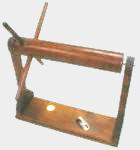
| ||
|
|||
|
Description Simple wooden machine. | |||
 Menu
Menu
|
Function It allows raising great weights with small forces. |
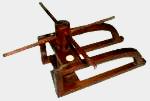
| ||
|
|||
|
Description Simple wooden machine. | |||
 Menu
Menu
|
Function Simple machine derived from the inclined plane. |

| ||
| |||
|
Description The two pieces are cut in hard wood. The nut is divided into two parts. | |||
 Menu
Menu
|
Function Simple machine derived from the inclined plane. |

| ||
|
|||
|
Description It is formed by a hard wooden prism with a triangular section. | |||
|
Function To study the equilibrium |
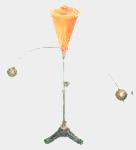
| ||
|
|||
|
Description At the end of the arc there are two spheres, one of which is fixed, while the other can move on the arc so that we can obtain the various types of equilibrium. | |||
 Menu
Menu
|
Function To study the stable, unstable, or neutral equilibrium for leaning bodies. |
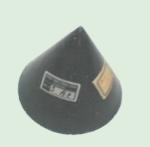
| ||
| |||
|
Description If we lay the cone on the base we obtain a stable equilibrium. If we lay it on the top we obtain an unstable equilibrium and if we lay it on the lateral surface we obtain a neutral equilibrium. | |||
 Menu
Menu
|
Function To study the condition of equilibrium of leaning bodies. |
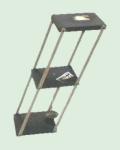
| ||
| |||
|
Description With the little pendulum applied to the centre of gravity we verify the condition of equilibrium of leaning bodies. The parallelepiped is formed by three wooden, equidistant and parallel planes articulated by four thin wooden bars, that form the lateral edges. | |||
 Menu
Menu
|
Function Mechanical paradox. To show that the centre of the mass tends toward the lowest level. |

| ||
|
|||
|
Description A wooden cylinder contains a mass of lead in an eccentric position. In that way the centre of the mass is placed far from the axis of the cylinder. By placing the cylinder in a particular position with the mass of lead over it, the disc rises to bring the centre of the mass to the lowest position. | |||
|
Function To show the inertia of bodies at rest. |
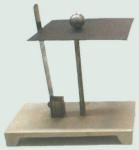
| ||
|
|||
|
Description A card and a sphere are placed on a little column. By freeing the spring placed in front, the card goes away but leaves the sphere on the top of the column. | |||
 Menu
Menu
|
Function This apparatus is normally called the flattening of the Earth. |
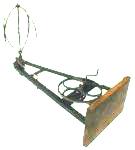
| ||
| |||
|
Description The two rings, fixed to the rotation axe at the bottom assume the form of an ellipse as soon as they are placed in rotation. If we imagine the steel ring divided into parts of equal mass, the centrifugal force is greater for these masses that are farther from the rotation axe. | |||
|
Function It is used to show that the plane of oscillation of a pendulum keeps its position constant. |
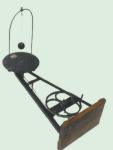
| ||
| |||
|
Description It is applied to the rotary apparatus, but to make the experiment it is only necessary to give a slow rotation to the base by hand, after making the pendulum oscillate. The oscillation plane keeps the original direction. | |||
|
Function To show that the centrifugal force is directly proportional to the mass. |
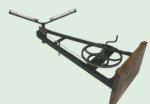
| ||
| |||
|
Description Two glass test tubes inclined and symmetrical with respect to the axe of rotation, hold water mercury and two balls of plumb and of cork oak. During the motion the different substances assume an inverse distribution from the normal one, because the centrifugal force is proportional to the density, when the volumes are equal. | |||
|
Function To study the functioning of a centrifuge. |
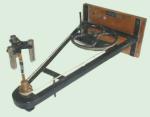 | ||
|
|||
|
Description From the top end of a pole three small arms with three test-tubes branch off at 120į angles. We fill the test-tubes with water and earth and we make them rotate. They dispose themselves horizontally and the earth which is heavier goes to the bottom. | |||
|
Function To study the central collisions. |
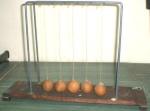
| ||
|
|||
|
Description It is formed by a set of pendulums hanging from a bar. They are made of elastic spheres of the same mass and of strings of the same length. The spheres are all in contact. The collision of the first sphere propagates through the others until the last. If one sphere is substituted to another made of inelastic material, the propagation of the collisions does not happen. | |||
|
Function To study molecular actions. |
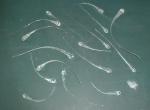
| ||
|
|||
|
Description Great drops of melted glass are dropped in cold water. Because of the instantaneous solidification of their surface, we have a very great and a very strong internal tension. The drops resist the shock but burst at the minimum superficial scratch or when we cut their top. | |||
|
Function To study the pressure on the bottom of containers, based on the principle of the communicating vessels. |
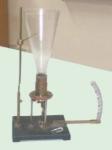
| ||
|
|||
|
Description It is formed by a container with the membrane. That membrane changes form under the weight of the liquid and moves a lever. | |||
|
Function To verify the Borelli - Jurin's law. |

| ||
|
|||
|
Description It is formed by four U shaped tubes (one is missing), each with a branch communicating with a capillary tube. The tubes are fixed to a wooden table placed on a support with a circular basis. The capillaries have different sections. Scales are used to determine the level of the liquid. | |||
|
Function To create very low pressures. |
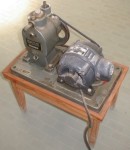
| ||
|
|||